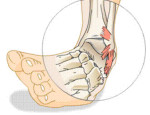The ligaments of the ankle hold the ankle bones and joint in position. They protect the ankle joint from abnormal movements-especially twisting, turning, and rolling of the foot. A sprained ankle is a very common ankle injury.
A ligament is an elastic structure. Ligaments usually stretch within their limits, and then go back to their normal positions. When a ligament is forced to stretch beyond its normal range, a sprain occurs. A severe sprain causes actual tearing of the elastic fibers.
How Ankle Injury Happens

Ankle sprains happen when the foot twists, rolls or turns beyond its normal motions. A great force is transmitted upon landing. You can sprain your ankle if the foot is planted unevenly on a surface, beyond the normal force of stepping. This causes the ligaments to stretch beyond their normal range in an abnormal position.
Mechanism of Ankle Injury
If there is a severe in-turning or out-turning of the foot relative to the ankle, the forces cause the ligaments to stretch beyond their normal length. If the force is too strong, the ligaments can tear. You may lose your balance when your foot is placed unevenly on the ground, especially during running. You may fall and be unable to stand on that foot. When excessive force is applied to the ankle’s soft tissue structures, you may even hear a “pop”. Ankle pain and swelling result.
The amount of force determines the grade of the sprain. A mild ankle sprain is a Grade 1. A moderate sprain is a Grade 2 and this usually implies a partial tear of the ankle ligaments. A severe strain is a Grade 3 and this is a complete tear of the ankle ligaments.
Diagnosis of Ankle Injury
See your doctor to diagnose a sprained ankle. He or she may order X-rays to make sure you don’t have a broken bone in the ankle or foot. A broken bone can have similar symptoms of pain and swelling.
The injured ligament may feel tender. If there is no broken bone, the doctor may be able to tell you the grade of your ankle sprain based upon the amount of swelling, pain and bruising.
The physical exam may be painful. The ankle doctor may need to move your ankle in various ways to see which ligament has been hurt or torn.
If there is a complete tear of the ligaments, the ankle may become unstable after the initial injury phase passes. If this occurs, it is possible that the ankle injury may also cause damage to the ankle joint surface itself.
The doctor may order an MRI (magnetic resonance imaging) scan if he or she suspects a very severe injury to the ligaments, injury to the joint surface, a small bone chip or other problem. The MRI can make sure the diagnosis is correct. The MRI may be ordered after the period of swelling and bruising resolves.
Symptoms of Ankle Injury
The amount of pain depends on the amount of stretching and tearing of the ligament. Chronic ankle instability occurs when there has been repeated injury or complete tearing of the ligament or a complete dislocation of the ankle joint.
Looking For A Reliable Foot & Ankle Orthopaedic Specialist?
Fast Medical Attention, Transparent Fees
Make an appointment for comprehensive care for your Foot & Ankle problems!
